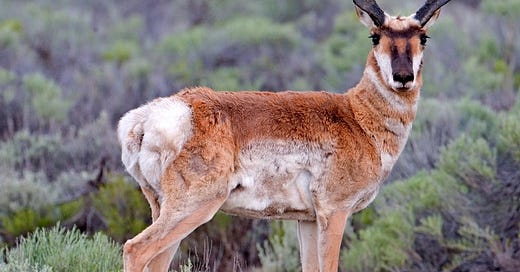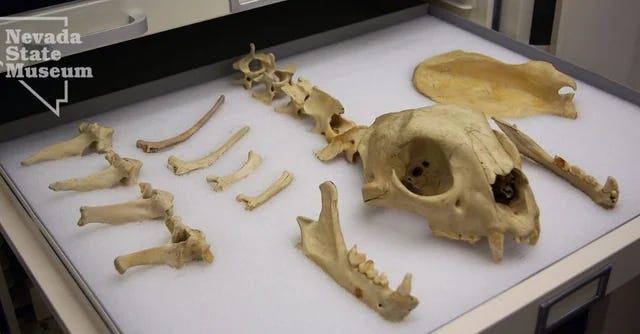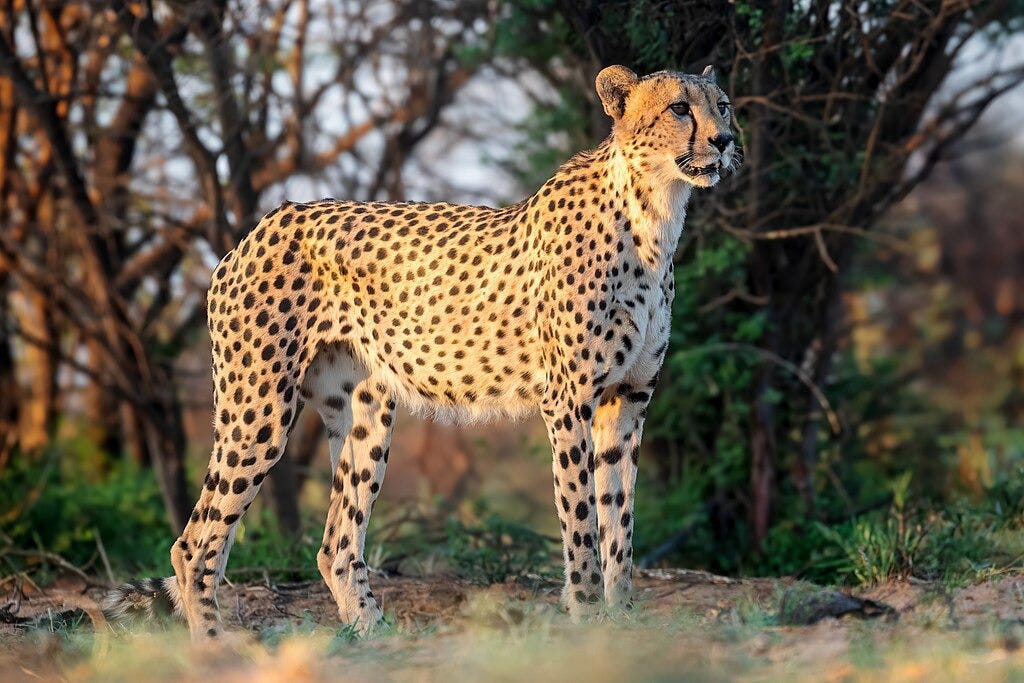The pronghorn (known colloquially as the “American antelope” or “prairie antelope”) is the fastest land mammal in North America, capable of reaching speeds of up to 55 miles per hour.
This makes it the world’s second fastest land mammal, number 2 right behind the cheetah, which can surpass 60 miles per hour. But the cheetah is an ocean away in Africa: the pronghorn is #1 in North America, and by a long shot, placing far ahead of North American’s second-place straggler, the coyote (which maxes out at around 40 mph.)
Speed is an adaptation that helps the pronghorn outrun predators. Why did it evolve a locomotor system capable of running 55 mph when there are no predators that come anywhere close to that speed?
The answer, it turns out, is that the pronghorn adapted to outrun a predator that no longer exists.
The Miracinonyx, colloquially known as the “American cheetah,” is believed to have gone extinct around 12,000 years ago, near the end of the last Ice Age. The “American cheetah” died out in the same extinction event that’s believed to have also killed off the woolly mammoth, saber-toothed cat, dire wolf, and giant ground sloth.
We can’t know for certain how fast the American cheetah was, but it’s widely speculated that it could reach speeds comparable to those of the present-day cheetah that we see in Africa.
The pronghorn’s top speed of 55 mph was the culmination of an evolutionary journey that spans tens of millions of years, with the real push for speed coming in the last few million years during the Ice Age, when North America was home to faster predators.
The American cheetah and American antelope were part of an evolutionary arms race, with each doing its best to stay ahead of the other. And, with the need for speed, selection pressure forced both species to make tradeoffs: while the pronghorn is fast, and is great at running in straight lines, it’s not agile. Part of this is the basic physics of momentum.
But a big part of the pronghorn’s lack of agility is biological: the pronghorn has a muscle distribution where strength is concentrated in the parts of the hindquarters that generate forward propulsion, but not the parts that would allow for more lateral movement. The pronghorn also has a more rigid spine compared to other prey animals, like the white-tailed deer.
While animals like deer can’t run faster than around 30 mph, they have a more “spring-like” anatomy that makes it easier for them to make rapid changes in direction.
And the speedy longhorn, like the cheetah, has a big problem with endurance. It has a high top speed, but can only maintain it for short bursts.
In short, the pronghorn is paying a lot of costs for a biological advantage that is no longer relevant. It evolved to outrun a threat that no longer exists.
I think that there is perhaps a metaphor in that.
There’s a scene in American Gods that can be read as a meditation on why prison has such a high recidivism rate:
Johnnie Larch had got to the airport, and he handed his ticket to the woman on the counter, and she asked to see his driver’s license.
He showed it to her. It had expired a couple of years earlier. She told him it was not valid as ID. He told her it might not be valid as a driver’s license, but it sure as hell was fine identification, and it had a photo of him on it, and his height and his weight, and damn it, who else did she think he was, if he wasn’t him?
She said she’d thank him to keep his voice down.
He told her to give him a f—ing boarding pass, or she was going to regret it, and that he wasn’t going to be disrespected. You don’t let people disrespect you in prison.
Then she pressed a button, and a few moments later the airport security showed up, and they tried to persuade Johnnie Larch to leave the airport quietly, and he did not wish to leave, and there was something of an altercation.
The conclusion that his fellow inmate comes to based on this anecdote is that the “kinds of behavior that work in a specialized environment, such as a prison, can fail to work and in fact become harmful when used outside such an environment.”
This generalizes beyond prisons, of course: there are behaviors that someone might develop to survive in a abusive household, or academic setting, or a toxic workplace, or a Pleistocene Ice Age. Those survival strategies might be useful or even necessary to survive in that environment.
But years pass, and later in life, those survival strategies might end up outliving their usefulness. These outdated survival strategies — and all of their associated costs — might end up persisting into the present, even though they were developed years ago to outrun a threat that no longer exists.
Related reading: DHH on “organizational scar tissue”







